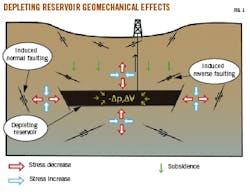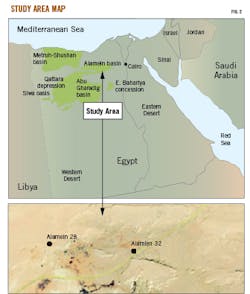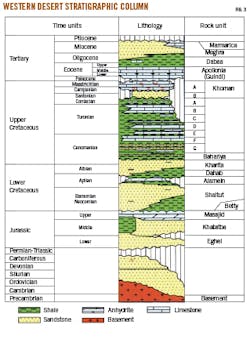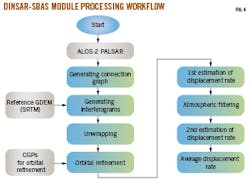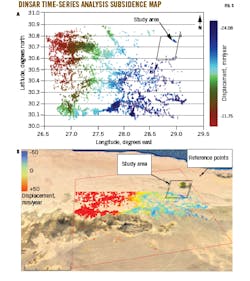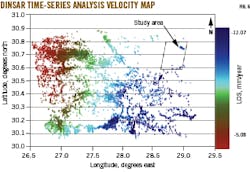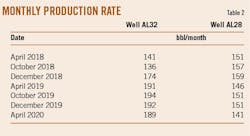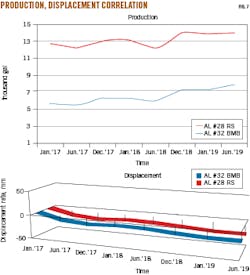Surface deformation reveals dynamic reservoir behaviors
Ahmed Hagag
Suez University
Alexandria University
Egypt
S. Elnaghi
Aly Mohamed Gad El Naggar
Alexandria University
Egypt
Eslam Alhogaraty
Aldar University College
Dubai
Ahmed Gaber
Port Said University
Egypt
Surface-deformation monitoring can provide valuable information on the dynamic behavior of reservoirs in production.1 Compacting reservoirs induce surface subsidence and contraction (Fig. 1).2-9 Measurement of these deformations identifies undepleted compartments, detects fault reactivation, and mitigates risks associated with the failure of the well.10-16 In addition, monitoring surface deformation is, in some countries, a legal requirement for oil extraction because extreme rock stresses lead to hole collapse and stuck pipe.17
Global Positioning System (GPS), optical levelling, tiltmeters, and satellite radar interferometry are the most frequent technologies used to detect surface subsidence.18-27 Among these technologies, only satellites employing interferometric synthetic aperture radar (InSAR) technology allow for comprehensive coverage over the area of interest, with a data point every few meters. InSAR provides precise measurement of soil-surface sinking to the millimeter level.28 29 For all other technologies, the distance between neighboring measurement points is on the scale of hundreds to thousands of meters, and data must be interpolated to obtain a displacement field.30-34 As a result, it is possible that characteristics with a shorter length scale will not be captured.
Differential interferometry, based on the topographic phase of SAR interferograms and an independent digital elevation model (DEM), provides precise surface deformation estimates. Different approaches of differential interferometry exist, including two-pass, three-pass, and four-pass interferometry.35 36 The technology also uses advanced algorithms such as permanent scatterers (PS) and small baseline subset (SBAS).37-41 This has allowed for millimeter-level precision in vertical subsidence motions.42 43
This study employed differential synthetic aperture radar interferometry (DInSAR) technology with the SBAS algorithm to monitor land subsidence rates in Egypt’s Western Desert.44 Synthetic aperture radar pictures were taken from advanced land observing satellite (ALOS) phased array type L-band synthetic aperture radar-2 (PALSAR-2) satellites from 2018-20 to precisely detect land deformation in the region and to correlate subsidence results with oil production rates.
Study area
Egypt’s Western Desert extends over an area of about 700,000 sq km.45 It covers 1,000 km from the Mediterranean shore in the north to the Sudanese border, and 600 to 800 km from the east of the Nile Valley to the Libyan border in the west.46 Geomorphologically, it is a plateau of stone desert with numerous large and deep closed-in topographic depressions.
Alamein Concession is in the northern part of the Western Desert, about 130 km southwest of Alexandria City, from 30° 20’ to 30° 50’ N and 28° 30’ and 28° 50’ E (Fig. 2).47 The first commercial oil discovery in the Western Desert was Alamein field. In 1966, Phillips Petroleum produced 8,000 bo/d of 34.5° API crude from the Aptian Alamein Dolomite reservoir. During drilling of Alamein development wells, oil and gas shows were consistently noticed in the Abu Roash “G” Dolomite, Middle Bahariya, and Razzak Sands reservoirs, which started to produce oil in 1993. Discovered in July 1971, Alamein-Yidma field, lying 6 km southwest of Alamein field, produces from the Alamein Dolomite reservoir.
Except for the Bahariya and Abu Roash areas, which are covered by Upper Cretaceous and Eocene silt, the northern portion of the Western Desert is covered by Miocene deposits (Fig. 3).48 49
Methods
In this study, SBAS processing applied the DInSAR technique to construct multiple master interferograms (MMI).50 51
SBAS identifies pixels consistent with phase stability during a specific observation period. The method uses MMI and works with restricted spatial baseline interferograms and short time intervals to solve decorrelations by expanding spatial and time sampling, as well as coherent zones.
For this study, the Japan Aerospace Exploration Agency’s ALOS-PALSAR satellite (JAXA) between 2018-20 took three ALOS-PALSAR images, which were converted to a Single Look Complex (SLC) format from their original Committee on Earth Observing System (CEOS) format. ALOS-PALSAR data were trimmed to the area of interest in Egypt’s Western Desert, focusing on Alamein areas with high-coherence pixels values alone to reduce computing time. SLC pictures of the research region were processed using ENVI SAR scape 5.2 software.52 SAR images with SLC were created using orbital data and sensor calibration in a freeware repeated orbit interferometry program. To account for topography fringes, differential interferograms were created using master and slave pictures, as well as a DEM. To produce coherent interferograms and reduce temporal decorrelation effects, two interferogram pairs (t1 and t2) were chosen with high coherence pixels.
Table 1 summarizes the normal and temporal baselines, as well as average coherence, which ranges from 0 to 1.53 54 Estimated values are based on spatial decorrelation (additive noise) and temporal decorrelation between master and slave acquisitions.55 56
Reference DEM was then used to remove topography from the interferograms. Differential interferograms with subsidence fringes were produced using shuttle radar topography mission (SRTM). Adaptive Goldstein filter phase unwrapping minimized phase noise and surface information to resolve ambiguity.
SBAS processing was also implemented by applying DInSAR to build MMIs.
Fig. 4 shows the processing workflow applied in this study using the SBAS module.
Results
Two interferograms were studied over 24 months to track land subsidence along the study area.
Fig. 5 shows the spatial distribution of land deformations obtained from the ALOS-PALSAR2 DInSAR study.
The greatest subsidence rate for t1 and t2 is -12.22 mm and -24.08 mm, respectively. The temporal gap between the master and slave photographs, as well as downward seasonal variation, could explain the difference between the two periods. Fig. 5 also demonstrates that subsidence in the study area is spatially homogenous.
Fig. 6 illustrates the mean velocity map derived from the DInSAR time series analysis, which is in the direction of the satellite’s line of sight (LOS) on the ground. In Alamein field, subsidence occurred at a maximum pace of roughly 24.08 mm/year from 2018-20.
Monthly production rates of oil wells AL32 and AL28 were recorded simultaneously with DInSAR analysis. The dataset assessed potential for non-tectonic impacts like oil extraction on surface deformations and the relationship of deformation rates with oil production.
Data results on production patterns and surface behavior of AL32 and AL28 show striking parallels between both wells during 2018-20 (Table 2, Fig. 7). Both wells experienced major fluctuations in operations over the same period, with lows occurring in December 2019, January 2020, February 2020, March 2020, and April 2020, and rises observed in December 2018 and October 2019. Well production increases from April 2018-April 2020 correlated with surface elevation decreases from -11.75 mm to -24.08 mm. The results show that deformation correlates with the petroleum production rate and could be used as a monitoring tool for extraction.
References
- Dusseault, M.B. and Rothenburg, L., “Analysis of deformation measurements for reservoir management,” Oil & Gas Science and Technology, Vol. 57, No. 5, Sept.-Oct. 2002, pp. 539–554.
- Muntendam-Bos, A.G., and Fokker, P.A., “Unraveling reservoir compaction parameters through the inversion of surface subsidence observations,” Computational Geosciences, Vol. 13, Vol. 1, Mar. 2009, pp. 43–55.
- de Waal, J.A. and Smits, R.M.M., “Prediction of reservoir compaction and surface subsidence: Field application of a new model,” SPE-14214-PA, Society of Petroleum Engineers Formation Evaluation, Vol. 3, No. 2, June 1, 1988, pp. 347–356.
- Bruno, M.S., “Identifying source mechanisms responsible for subsidence through inversion of measured surface displacements,” In Proc. Dr. Joseph F. Poland Symposium on Land Subsidence, Belmont, Cali., 1998, pp. 441–449.
- Finol, A. and Farouq Ali, S.M., “Numerical simulation of oil production with simultaneous ground subsidence,” SPE-4847-PA, Society of Petroleum Engineers (SPE) Vol. 15, No. 5, Oct. 1, 1975, pp. 411–424.
- Gambolati, G., Teatini, P., and Ferronato, M., “Anthropogenic land subsidence,” Groundwater, Encyclopedia of Hydrological Sciences, Vol. 13, Apr. 15, 2006, pp. 2443-2459.
- Galloway, D. L. and Burbey, T. J., “Review: Regional land subsidence accompanying groundwater extraction,” Hydrogeology Journal, Vol. 19, No. 8, Aug. 26, 2011, pp. 1459–1486.
- Hu, B., Li, H., Zhang, X., and Fang, L., “Oil and gas mining deformations monitoring and assessments of Disaster: Using INSAR technology,” IEEE Geo-Science Remote Sensing Magazine, Vol. 8, No. 2, May 14, 2020, pp. 108-134.
- Segall, P.,”Earthquakes, triggered by fluid extraction,” Geology, Vol. 17, No. 10, Oct. 1, 1989, pp. 942-946.
- Du, J. and Wong, R.C.K., “Development of a coupled geomechanics-thermal reservoir simulator using finite element method,” PETSOC-2005-027, Canadian International Petroleum Conference, Calgary, Alberta, Canada, June 7, 2005.
- Vasco, D.W. and Ferretti, A., “On the use of quasi-static deformation to understand reservoir fluid flow,” Geophysics, Vol. 70, No. 4, January 2005, pp. O13–O27.
- de Peter, H., de Koning, J., Maxell, S., and Walters, D., “Geomechanics for interpreting SAGD monitoring using micro-seismicity and surface tiltmeters,” SPE/PS/CHOA 117688, Society of Petroleum Engineers International Thermal Operations and Heavy Oil Symposium, Calgary, 2008.
- Du, J., Brissenden, S.J., McGillivray, P.R., Bourne, S., Hofstra, P., Davis, E.J., Roadarmel, W.H., Wolhart, S.L., Marsic, S., Gusek, R.W., and Wright, C.A., “Mapping reservoir volume changes during cyclic steam stimulation using tiltmeter-based surface deformation measurements,” SPE-97848-MS, SPE International Thermal Operations and Heavy Oil Symposium, Calgary, Alberta, Canada, Nov. 1, 2005.
- Muntendam-Bos, A.G., Kroon, I.C., and Fokker, P.A., “Time-dependent inversion of surface subsidence due to dynamic reservoir compaction,” Mathematical Geosciences, Vol. 40, Jan. 24, 2008, pp. 159–177.
- Maxwell, S.C., Du, J., Shemeta, J., Zimmer, U., Boroumand, N., and Griffin, L.G., “Monitoring SAGD steam injection using microseismicity and tiltmeters,” SPE-110634-PA, SPE Reservoir Evaluation and Engineering, Vol. 12, No. 2, Apr. 14, 2009, pp. 311–317.
- Khakim, M.Y.N., Tsuji, T., and Matsuoka, T., “Geomechanical modeling for InSAR-derived surface deformation at steam-injection oil sand fields,” Journal of Petroleum Science and Engineering, Vol. 96-97, October 2012, pp. 152–161.
- Segall, P. and Fitzgerald, S.D., “A note on induced stresses changes in hydrocarbon and geothermal reservoirs,” Tectonophysics, Vol. 289, 1998, pp.117-128.
- Burgmann, R., Rosen, R.A., and Fielding, E.J., “Synthetic aperture radar interferometry to measure Earth’s surface topography and its deformation,” Annual Reviews of Earth and Planetary Sciences, Vol. 28, 2000, pp. 169-209.
- Ferretti, A., Prati, C., and Roca, F., “Permanent scatters in SAR interferometry,” IEEE Transactions on Geoscience and Remote Sensing, Vol. 39, No. 1, January 2001, pp. 8-10.
- Ferretti, A., Prati, C., and Roca, F. “Nonlinear subsidence rate estimation using permanent scatterers in differential SAR interferometry,” IEEE Transactions on Geoscience and Remote Sensing, Vol. 38, No. 5, September 2000, pp. 2202-2212.
- Ferretti, A., Prati, C., and Roca, F., “Permanent Scatters in SAR Interferometry,” IEEE Transactions on Geoscience and Remote Sensing, Vol. 39, No. 1, January 2001, pp. 8-20.
- Gabriel, A.K., Goldstein, R.M., and Zebker, H.A., “Mapping small elevation changes over large areas: differential radar interferometry,” Journal of Geophysical Research, Vol. 94, No. B7, July 10, 1989, pp. 9183-9191.
- Klees, R. and Massonnet, D., “Deformation measurements using SAR interferometry: Potentials and Limitations,” Geologie en Mijnbouw, Vol. 77, June 1998, pp. 161-176.
- Madsen, S.N., Zebker, H.A., and Martin, J., “Topographic mapping using radar interferometry: processing techniques,” IEEE Transactions on Geoscience and Remote Sensing, Vol. 31, No. 1, January 1993, pp. 246-255.
- Massonnet, D., Rossi, M., Carmona, C, Adragna, F., Peltzer, G, Feigl, K., and Rabaute, T., “The displacement field of the Landers Earthquake mapped by radar interferometry,” Nature, Vol. 364, July 8, 1993, pp. 138-142.
- Zebker, H.A and Goldstein, R.M., “Topographic mapping from interferometric synthetic aperture radar observations,” Journal of Geophysical Research, Vol. 91, No. B5, Apr. 10, 1996, pp. 4993-4999.
- Nagel, N.B., “Compaction and subsidence issues within the petroleum industry: From Wilmington to Ekofisk and beyon,” Physics and Chemistry of the Earth, Part A: Solid Earth and Geodesy, Vol. 26, Issues 1-2, 2001, pp. 3–14.
- Bamler, R. and Hartl, P., “Synthetic aperture radar interferometry,” Inverse Problems, Vol. 14, No. 4, Aug. 1, 1998.
- Li, D., Hou, X., Song, Y., Zhang, Y., and Wang, C., “Ground deformation analysis in Tianjin China based on Sentinel- 1A data using MT-InSAR methods,” Applied Science, Vol. 10, No. 16, Aug. 11, 2020, pp. 5514.
- Massonnet, D., Feigl, K., Rossi, M., and Adragna, F., “Radar interferometry mapping of deformation in the year after the Landers Earthquake,” Nature, Vol. 369, May 19, 1994, pp. 227-230.
- Massonnet, D., Briole, P., and Arnaud, A., “Deflation of Mount Etna monitored by spaceborne radar interferometry,” Nature, Vol. 375, June 15, 1995, pp. 567–570.
- Murakami, M., Tobita, M., Fujiwara, S., and Saito, T., “Co seismic crustal deformations of 1994 Northridge, California, Earthquake detected by interferometric JERS 1 synthetic aperture radar,” Journal of Geophysical Research, Vol. 101, No. B4, April 10, 1996, pp. 8605-8614.
- Tobita, M., Fujiwara, S., Ozawa, S., Rosen, P.A., Fielding, E.J., Werner, C.L., Murakami, M., Nakagawa, H., Nitta, K., and Murakami, M., “Deformation of the 1995 North Sakhalin Earthquake detected by JERS-1/SAR interferometry,” Earth Planet Space, Vol. 50, April 1998, pp. 313-325.
- Zebker, H.A., Rosen, P.A., Goldstein, R.M., Gabriel, A., and Werner, C.L., “On the derivation of coseismic displacement fields using differential radar interferometry; The Landers Earthquake.” Journal of Geophysical Research, Vol. 99, No. B10, Oct. 10, 1994, pp. 19617-19634.
- Gabriel, A.K., Goldstein, R.M., and Zebker, H.A., “Mapping small elevation changes over large areas: differential radar interferometry,” Journal of Geophysical Research, Vol. 94, No. B7, July 10, 1989, pp. 9183-9191.
- Ferretti, A., Monti-Guarnieri, A., Prati, C., Rocca, F., and Massonnet, D., “InSAR Principles: Guidelines for SAR interferometry Processing and Interpretation,” ESA Publications, ESTEC, 2007.
- Massonnet, D., Feigl, K.L., “Radar Interferometric and its Applications to changes in the Earth’s surface,” Rev-Geophys., Vol. 36, No. 4, Nov. 1, 1998, pp. 441-500.
- Peltzer, G., Hudnut, K.W., and Feigl, K.L., “Analysis of Coseismic surface displacement gradients using radar interferometry: New insights into the Landers earthquake,” J. Geo-phys. Res. Solid Earth, Vol. 99, No. B11, Nov. 10, 1994, pp. 21971–21981.
- Berardino, P., Fornaro, G., Lanari, R., and Sansosti, E., “A new algorithm for surface deformation monitoring based on Small Baseline Differential SAR Interferograms,” IEEE Trans. Geoscience and Remote Sensing., Vol. 40, No. 11, November 2002, pp. 2375-2383.
- Colesanti, C, Ferretti, A., Prati, C., and Rocca, F., “Full exploitation of the ERS archive: multi data set permanent scatterers analysis,” IEEE Proceedings of the International Geoscience and Remote Sensing Symposium, Vol. 2, June 24-28, 2002, pp. 1234-1236.
- Colesanti, C, Locatelli, R., and Novali, F., “Ground deformation monitoring exploring SAR permanent scatterers,” IEEE Proceedings of the International Geoscience and Remote Sensing Symposium, Vol. 2, June 24-28, 2002, pp. 1219-1221.
- Massonnet, D., Feigl, K., Rossi, M., Adragna, F., “Radar interferometric mapping of deformations in the year after the Landers earthquake,” Nature, Vol. 369, 1996, pp. 227–230.
- Yhokha, A., Chang, C.-P., Goswami, P.K., Yen, J.-Y., Lee, S.-I,. “Surface deformations in the Himalaya and Adjoining piedmont zone of the Ganga plain, Uttarakhand, India, determined by different Radar interferometric techniques,” J. Asian Earth Sciences, Vol. 106, July 1, 2015, pp. 119-129.
- Henderson, F.M. and Lewis, A.J., “Principles and Applications of Imaging Radar. Manual of Remote Sensing,” JohnWiley and Sons, Hoboken, NJ, Third edition, Vol. 2., 1998.
- Egyptian General Petroleum Corp., “Western Desert Gas and Oil Fields, a Comprehensive Overview,” EGPC 11th Petroleum Exploration and Production Conference, Cairo, Egypt, Nov. 7-10, 1992, p. 1-431.
- Abdel Halim, M. and Moussad, M.A., “EGPC, Western Desert oil and Gas Fields,” Rock stratigraphic nomenclature of the western desert, Pan Am. UAR Oil Company, Cairo, No. 41, 1992.
- EGPC and Schlumberger Middle East SA, “Western Desert- WEC Egypt,” Well Evaluation Conference (WEC), 1995, p. 60-77.
- Said, R., “Geology of Egypt,” Amsterdam, Elsevier Science Publishing Co. Inc., 1962.
- Schlumberger, Well Evaluation Conference, Egypt, 1995.
- Wegmuller, U., Werner, C., Strozzi, T., and Wiesmann, A., “Applications of SAR interferometric techniques for surface deformation monitoring,”3rd IAG and FIG Symposium, Baden, Germany, May 22-24, 2006.
- Chen, Y.Q., Zhang, G.B., Ding, X.L., and Li, Z.L., “Monitoring Earth surface deformations with InSAR technology: principle and some critical issues,” Journal of Geospatial Engineering, Vol. 2, No. 1, 2000, pp. 3-21.
- Sarmap SA., ENVI SARscape 5.2, Switzerland, 2015.
- Rosen, P.A., Hensley, S., Zebker, H.A., Webb, F.H., and Fielding, E.J., “Surface deformation and coherence measurements of Kilauea Volcano, Hawaii, from SIR-C radar interferometry,” Journal of Geophysical Research, Vol. 101, No. E10, Oct. 1, 1996, pp. 23109-23125
- Rosen, R.A., Hensley, S., Joughin, I.R., Li, F.K., Madsen, S.N., Roudriquez, E., and Goldstein, R.M., “Synthetic aperture radar interferometry,” Proceeding of the IEEE, Vol. 88, No. 3, March 2000, pp. 333-382.
- Villasenor, J. and Zebker, H.A., “Temporal decorrelation in repeat-pass radar interferometry,” Proceedings of the IEEE International Geoscience and Remote Sensing Symposium, Vol. 2, May 26-29, 1992, pp. 941-943.
- Zebker, H.A. and Villasenor, J., “Decorrelation in interferometric radar echoes,” IEEE Transactions on Geoscience and Remote Sensing, Vol. 30, No. 5, September 1992, pp. 950-959.
